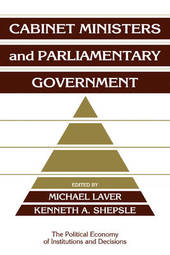
|
Cabinet Ministers and Parliamentary Government
Paperback / softback
Main Details
| Title |
Cabinet Ministers and Parliamentary Government
|
| Authors and Contributors |
Edited by Michael Laver
|
|
Edited by Kenneth A. Shepsle
|
| Series | Political Economy of Institutions and Decisions |
|---|
| Physical Properties |
| Format:Paperback / softback | | Pages:332 | | Dimensions(mm): Height 226,Width 151 |
|
| ISBN/Barcode |
9780521438377
|
| Classifications | Dewey:354.4104 |
|---|
| Audience | | Professional & Vocational | |
|---|
| Illustrations |
Worked examples or Exercises
|
|
Publishing Details |
| Publisher |
Cambridge University Press
|
| Imprint |
Cambridge University Press
|
| Publication Date |
30 September 1994 |
| Publication Country |
United Kingdom
|
Description
One of the key constitutional features of a parliamentary democracy is that the political executive, or cabinet, derives its mandate from-and is politically responsible to-the legislature. What makes a parliamentary democracy democratic is that, once a legislative election has been held, the new legislature has the power to dismiss the incumbent executive and replace it with a new one. Moreover, it sits essentially as a court, passing continual judgment on the record of the executive, and continuous sentence on its future prospects. That is how citizens, indirectly, choose and control their government. But the relationship between legislature and executive is not one-sided. The executive typically has the authority to recommend dissolution of parliament and is usually drawn from the parliament. Executive personnel, therefore, have intimate familiarity with parliamentary practices; and for their part, parliamentary personnel aspire to executive appointments. Surprisingly little is known about the constitutional relationship between legislature and executive in parliamentary regimes; the present volume seeks to remedy this. Leading specialists on institutional politics in the major parliamentary democracies have been encouraged to describe legislative- executive interactions in terms of a common theoretical framework. The country-specific chapters have, as their central themes, cabinet decision making and cabinet relationships with the parliament, parliamentary parties, and the permanent civil service. The editors have provided a theoretical overview at the outset and, in their conclusion, have made theoretical sense of the empirical variation in parliamentary practices.
|